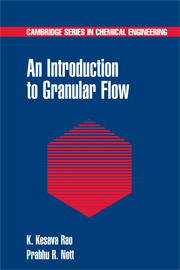Book contents
- Frontmatter
- Contents
- Preface
- Notation
- 1 Introduction
- 2 Theory for Slow Plane Flow
- 3 Flow through Hoppers
- 4 Flow through Wedge-Shaped Bunkers
- 5 Theory for Slow Three-Dimensional Flow
- 6 Flow through Axisymmetric Hoppers and Bunkers
- 7 Theory for Rapid Flow of Smooth, Inelastic Particles
- 8 Analysis of Rapid Flow in Simple Geometries
- 9 Theory for Rapid Flow of Rough, Inelastic Particles
- 10 Hybrid Theories
- Appendix A Operations with Vectors and Tensors
- Appendix B The Stress Tensor
- Appendix C Hyperbolic Partial Differential Equations of First Order
- Appendix D Jump Balances
- Appendix E Discontinuous Solutions of Hyperbolic Equations
- Appendix F Proof of the Coaxiality Condition
- Appendix G Material Frame Indifference
- Appendix H The Evaluation of Some Integrals
- Appendix I A Brief Introduction to Linear Stability Theory
- Appendix J Pseudo Scalars, Vectors, and Tensors
- Appendix K Answers to Selected Problems
- References
- Index
1 - Introduction
Published online by Cambridge University Press: 19 November 2009
- Frontmatter
- Contents
- Preface
- Notation
- 1 Introduction
- 2 Theory for Slow Plane Flow
- 3 Flow through Hoppers
- 4 Flow through Wedge-Shaped Bunkers
- 5 Theory for Slow Three-Dimensional Flow
- 6 Flow through Axisymmetric Hoppers and Bunkers
- 7 Theory for Rapid Flow of Smooth, Inelastic Particles
- 8 Analysis of Rapid Flow in Simple Geometries
- 9 Theory for Rapid Flow of Rough, Inelastic Particles
- 10 Hybrid Theories
- Appendix A Operations with Vectors and Tensors
- Appendix B The Stress Tensor
- Appendix C Hyperbolic Partial Differential Equations of First Order
- Appendix D Jump Balances
- Appendix E Discontinuous Solutions of Hyperbolic Equations
- Appendix F Proof of the Coaxiality Condition
- Appendix G Material Frame Indifference
- Appendix H The Evaluation of Some Integrals
- Appendix I A Brief Introduction to Linear Stability Theory
- Appendix J Pseudo Scalars, Vectors, and Tensors
- Appendix K Answers to Selected Problems
- References
- Index
Summary
A granular material is a collection of solid particles or grains, such that most of the particles are in contact with at least some of their neighboring particles. The terms “granular materials,” “bulk solids,” “particulate solids,” and “powders” are often used interchangeably in the literature. Common examples of granular materials are sand, gravel, food grains, seeds, sugar, coal, and cement. Figure 1.1 shows the typical size ranges for some of these materials.
Granular materials are commonly encountered in nature and in various industries. For example, with reference to the chemical industry, Ennis et al. (1994) note that about 40% of the value added is linked to particle technology. Similarly, Bates (2006) notes that more than 50% of all products sold are either granular in form or involve granular materials in their production. In spite of the importance of granular materials, their mechanics is not well understood at present. Nevertheless, some progress has been made during the past few decades. The goal of this book is to describe some of the experimental observations and models related to the mechanical behavior of flowing granular materials. As studies in this area are increasing rapidly, our account is necessarily incomplete. However, it is hoped that the book will provide a useful starting point for the beginning student or researcher.
A material is called a dry granular material if the fluid in the interstices or voids between the grains is a gas, which is usually air. On the other hand, if the voids are completely filled with a liquid such as water, the material is called a saturated granular material.
- Type
- Chapter
- Information
- An Introduction to Granular Flow , pp. 1 - 53Publisher: Cambridge University PressPrint publication year: 2008



